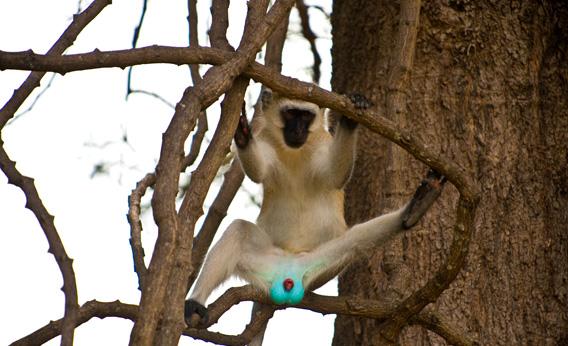Soccer fans call it brave goalkeeping, the act of springing
into a star shape in front of an attacker who is about to kick the ball
as hard as possible toward the goal. As I shuffled from the field, bent
forward, eyes watering, waiting for the excruciating whack of pain in my
crotch to metamorphose into a gut-wrenching ache, I thought only stupid goalkeeping. But after the fourth customary slap on the back from a teammate chortling, “Hope you never wanted kids, pal,” I thought only stupid, stupid testicles.
 |
| A vervet monkey's neon scrotum
Courtesy of Gijs Joost Brouwer
|
Some of you may be thinking that there is a simple answer:
temperature. This arrangement evolved to keep them cool. I thought so,
too, and assumed that a quick glimpse at the scientific literature would
reveal the biological reasons and I’d move on. But what I found was
that the small band of scientists who have dedicated their professional
time to pondering the scrotum’s existence are starkly divided over this
so-called cooling hypothesis.
Reams of data show that scrotal sperm factories, including our own, work best a few degrees below core body temperature.
The problem is, this doesn’t prove cooling was the reason that
testicles originally descended. It’s a straight-up chicken-and-egg
situation—did testicles leave the kitchen because they couldn't stand
the heat, or do they work best in the cold because they had to leave the
body?
Vital organs that work optimally at 98.5 degrees Fahrenheit get bony
protection: My brain and liver are shielded by skull and ribs, and my
girlfriend’s ovaries are defended by her pelvis. Forgoing skeletal
protection is dangerous. Each year, thousands of men go to the hospital
with ruptured testes or torsions caused by having this essential organ
suspended chandelierlike on a flexible twine of tubes and cords. But
having exposed testicles as an adult is not even the most dangerous
aspect of our reproductive organs’ arrangement.
Read More
Read More

No comments:
Post a Comment